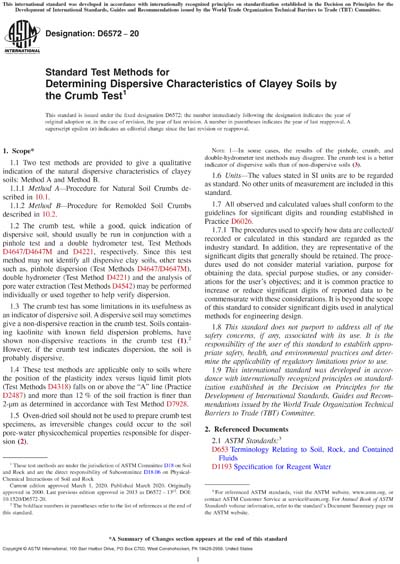Historical
ASTM D6572-20
Standard Test Methods for Determining Dispersive Characteristics of Clayey Soils by the Crumb Test
1.1 Two test methods are provided to give a qualitative indication of the natural dispersive characteristics of clayey soils: Method A and Method B.
1.1.1 Method A—Procedure for Natural Soil Crumbs described in 10.1.
1.1.2 Method B—Procedure for Remolded Soil Crumbs described in 10.2.
1.2 The crumb test, while a good, quick indication of dispersive soil, should usually be run in conjunction with a pinhole test and a double hydrometer test, Test Methods D4647/D4647M and D4221, respectively. Since this test method may not identify all dispersive clay soils, other tests such as, pinhole dispersion (Test Methods D4647/D4647M), double hydrometer (Test Method D4221) and the analysis of pore water extraction (Test Methods D4542) may be performed individually or used together to help verify dispersion.
1.3 The crumb test has some limitations in its usefulness as an indicator of dispersive soil. A dispersive soil may sometimes give a non-dispersive reaction in the crumb test. Soils containing kaolinite with known field dispersion problems, have shown non-dispersive reactions in the crumb test (1).2 However, if the crumb test indicates dispersion, the soil is probably dispersive.
1.4 These test methods are applicable only to soils where the position of the plasticity index versus liquid limit plots (Test Methods D4318) falls on or above the “A” line (Practice D2487) and more than 12 % of the soil fraction is finer than 2-μm as determined in accordance with Test Method D7928.
1.5 Oven-dried soil should not be used to prepare crumb test specimens, as irreversible changes could occur to the soil pore-water physicochemical properties responsible for dispersion (2).
Note 1: In some cases, the results of the pinhole, crumb, and double-hydrometer test methods may disagree. The crumb test is a better indicator of dispersive soils than of non-dispersive soils (3).
1.6 Units—The values stated in SI units are to be regarded as standard. No other units of measurement are included in this standard.
1.7 All observed and calculated values shall conform to the guidelines for significant digits and rounding established in Practice D6026.
1.7.1 The procedures used to specify how data are collected/recorded or calculated in this standard are regarded as the industry standard. In addition, they are representative of the significant digits that generally should be retained. The procedures used do not consider material variation, purpose for obtaining the data, special purpose studies, or any considerations for the user’s objectives; and it is common practice to increase or reduce significant digits of reported data to be commensurate with these considerations. It is beyond the scope of this standard to consider significant digits used in analytical methods for engineering design.
1.8 This standard does not purport to address all of the safety concerns, if any, associated with its use. It is the responsibility of the user of this standard to establish appropriate safety, health, and environmental practices and determine the applicability of regulatory limitations prior to use.
1.9 This international standard was developed in accordance with internationally recognized principles on standardization established in the Decision on Principles for the Development of International Standards, Guides and Recommendations issued by the World Trade Organization Technical Barriers to Trade (TBT) Committee.
Content Provider
ASTM International [astm]






